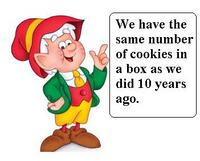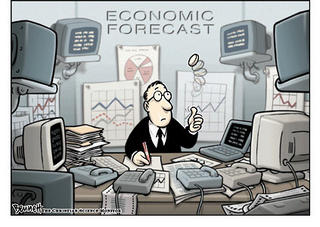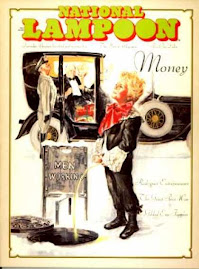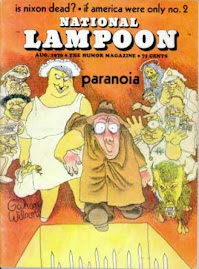Kilber's Cookie Crumbles With Voo Doo Math Statistics

The administrator of the www.ontheborderline.net blog had a letter published in today's New Richmond News. Chris Kilber's letter focused on the discussion within the New Richmond school district concerning the need for school additions and/or new schools. Mr. Kilber got out his smoke-n-mirrors and confounded readers with a limp array of undocumented "facts" and "figures."
His first point was to point out that "as a citizen of Wisconsin,100 percent of my state income tax goes to the state of Wisconsin, who in turn sends it out to the local school districts throughout the state."
I'll agree with CK on the first half of this statement: 100 percent of my state income tax also goes to the state of Wisconsin. Where else would it be going? It sounds like CK thinks the state then takes 100 percent of his taxes and sends it out to local school districts in Wisconsin. I would say only a portion of his state taxes go to local school districts. Other portions go to building roads, running the state, tourism, health care, agriculture, etc.
CK says "Wisconsin has a business climate that is one of the worst three states in the country and has been touted as a tax hell."
That's a hip shot...Where does he get this ranking from? A quick Google search on state rankings brings me to the Tax Foundation site which, in its 2004 State Business Tax climate Index Ranking by State, says Wisconsin ranks #41. That leaves 9 states below Wisconsin. On this blog site 9 don't equal 3...even if a 6 turned out to be 9.
The 2004 Tax Foundation rank for Corporate Income Tax put Wisconsin at #20 and for Individual Income Tax we ranked #32.
How about these stats:
Business taxes are lower in Wisconsin than those in 35 other states, according to a 2005 study by the Federal Reserve Bank of Boston, which measures more than 15 taxes that can affect corporate profits.
On the Inc. Magazine 2004 Top 25 Cities for Doing Business in America list, Green Bay and Madison ranked 1-2 among medium metro areas and La Crosse ranked 17th among small metro areas.
Favorable business tax policies:
1. Property tax exemptions for manufacturing machinery and equipment, computers and computer equipment; inventories, and pollution-control equipment; tax credits for energy used in manufacturing and for R&D.
2. 60-percent capital gains exclusion.
3. No inheritance and gift taxes.
4. No unitary tax on foreign-owned corporations.
5. Single-sales-factor tax treatment adopted
Changes in Wisconsin's incorporation law have caused a number of state companies to reincorporate in Wisconsin from Delaware. Wisconsin has the most up-to-date law on the books, and does not charge a franchising fee.
Some statistics sites to check out:
Wisconsin Commerce site
Tax Foundation publications
----- CK also tells us the public school population hasn't changed in the last 10 years. According to statistics on the Wisconsin Department of Public Instruction web site, in 1994-95 there were 860,581 public school students and in 2003-04 (mosavailablet avaiable) there were 880,031. That's 19,450 more students or an increase of 2.3%. Where I went to school that's an increase. Of course, even if the student population remained the same in Wisconsin, that wouldn't eliminate the need to building new schools or add on additions. In western Wisconsin school districts, the average increase in student population was +7.3%. Of course, we probably wouldn't have had to spend the $5.1 billion (where did this figure come from Chris) that CK claims was spent in the past 10 years, if we bused Hudson, River Falls, Somerset, etc. kids to school in Milwaukee or Hurley or Platteville.
CK also tells us the public school population hasn't changed in the last 10 years. According to statistics on the Wisconsin Department of Public Instruction web site, in 1994-95 there were 860,581 public school students and in 2003-04 (mosavailablet avaiable) there were 880,031. That's 19,450 more students or an increase of 2.3%. Where I went to school that's an increase. Of course, even if the student population remained the same in Wisconsin, that wouldn't eliminate the need to building new schools or add on additions. In western Wisconsin school districts, the average increase in student population was +7.3%. Of course, we probably wouldn't have had to spend the $5.1 billion (where did this figure come from Chris) that CK claims was spent in the past 10 years, if we bused Hudson, River Falls, Somerset, etc. kids to school in Milwaukee or Hurley or Platteville.
The wheels are always spinning over on the other side of the borderline. It's too bad they don't engage their mental clutch.
CK also says "taxes are driving citizens and business out of the state."
Let's see...
Wisconsin's population growth:
Demographic trends drive the demand for goods and services and underpin the ability to attract workers and employers. The number of producers and consumers is one of the first pieces information needed for any plan of business or public service. This article examines basic elements of WisconsinÂ’s population growth.
Where the growth happens:
The Wisconsin Department of Administration's Demographic Services Center estimates that 5,490,718 people lived Wisconsin as of January 2003. This reflects an increase of 127,074 people over the 2000 Census. Natural increase (births minus deaths) accounted for roughly 49,812 people, or 39 percent of the increase. Net migration (people moving in minus people moving out) contributed the other 77,202 people, or 61% of that increase.
Non-metropolitan Wisconsin enjoyed a faster rate of net migration, (2.02%) than metropolitan Wisconsin (1.16%). Nonetheless, metropolitan Wisconsin's rate of natural increase (1.23%) was far enough ahead of non-metropolitan Wisconsin's (0.29%), that metropolitan Wisconsin's overall growth rate (2.39%) was slightly greater than non-metropolitan Wisconsin's (2.32%). Of the state's total natural increase (49,812 people), approximately 89.9 percent (44,766 people) were added to metropolitan areas.
Check the Wisconsin Department of Workforce Development
Yes, it is true that taxpayers are leaving the state, but more are coming in. Maybe CK is making his observation based on the recent exit from Wisconsin of his blog mate Bill D. Concerning businesses leaving the state, I'm sure some are and, likewise, there are businesses coming into the state and jobs are being created within the state. It's called "churn." Interestingly enough, Wisconsin is cutting government jobs and gaining in non-government jobs. The info below comes from September 2004.
Read on...
The U.S. Bureau of Labor Statistics report helped to explain why Madison, which is often touted for its private sector growth, was relatively flat in total employment. Madison is the center of state government, which has been downsized by Gov. Jim Doyle and the Legislature as they attempt to keep state spending under control. While Madison's tech and service sectors continue to churn out jobs, it is basically breaking even with the decline in government payrolls.
According to federal statistics, Wisconsin ranked behind only a half-dozen states in cutting government jobs in the past year or so. All of those states are larger: California, New York, Texas, Pennsylvania, Michigan and Missouri. In percentage terms, Wisconsin appears to rank No. 1 in shedding government jobs. (Unfortunately, some were federal jobs the state would have preferred to keep.)
The state grew in nearly every other job sector tracked by the Labor Department, showing 1.7 percent job growth (48,800 jobs) since mid-2003. The state's unemployment rate of 4.6 percent is down from 5.8 percent a year earlier and compares to 5.7 percent nationally.
Check the Wisbus.com
site for more information.
----- I could go on, but the point is CK is flinging out statements that don't with jive the numbers. You can say anyone can find statistics to back up their argument and that's exactly what I did here. It didn't take long. CK is guilty of making snapshot judgements as are some of the other borderliners. They did a post a couple weeks ago telling about a house in Hudson or North Hudson that's been for sale for two years. This is accompanied by talk that this proves houses are not selling in Hudson.
I could go on, but the point is CK is flinging out statements that don't with jive the numbers. You can say anyone can find statistics to back up their argument and that's exactly what I did here. It didn't take long. CK is guilty of making snapshot judgements as are some of the other borderliners. They did a post a couple weeks ago telling about a house in Hudson or North Hudson that's been for sale for two years. This is accompanied by talk that this proves houses are not selling in Hudson.
Take a drive out by the old Charlie Ward farm area down County Road N. Two years ago they were just starting to dig up dirt out there. Now look at it. Go farther east on N and see those developments. Hang a left and head north to Badlands road. Maybe those OTBL'ers need to get out more...and preferrablely during the daylight hours.



























No comments:
Post a Comment